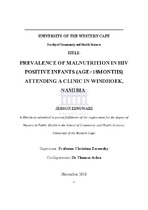| dc.contributor.advisor | Zarowsky, Christina | |
| dc.contributor.advisor | Achia, Thomas | |
| dc.contributor.author | Zingwari, Jebson | |
| dc.contributor.other | School of Public Health | |
| dc.contributor.other | Faculty of Community and Health Sciences | |
| dc.date.accessioned | 2013-06-14T07:35:31Z | |
| dc.date.available | 2013/03/04 12:50 | |
| dc.date.available | 2013/03/04 | |
| dc.date.available | 2013-06-14T07:35:31Z | |
| dc.date.issued | 2010 | |
| dc.identifier.uri | http://hdl.handle.net/11394/1425 | |
| dc.description | Magister Public Health - MPH | en_US |
| dc.description.abstract | Background-Namibia has a high HIV and malnutrition burden. HIV increases the risk of malnutrition and malnutrition results in rapid progression of the disease and worsening malnutrition. Nutrition plays an important role in the management of an HIV positive child. Optimal nutrition delays disease progression, improves immune function and the effectiveness of antiretroviral drugs thereby improving the quality of life of the child. Early identification of children at risk of malnutrition is therefore essential to prevent malnutrition in HIV positive children. Methodology-The study sought to determine the prevalence and the risk factors for malnutrition in 88 HIV positive children less than 18 months attending Hospital Paediatric ARV Clinic (HPAC). The study used quantitative methods. A questionnaire was administered to the child's caregiver to assess infant, caregiver and socio-economic risk factors for malnutrition after written consent had been obtained. The history of the patient was extracted from the HIV patient care booklet. Nutritional status was assessed using WHO standard growth charts in children and body mass index (BMI) in adults. Results- The study showed that 56.8% of children were wasted (14.8% had severe wasting), 52.3% were stunted (18.2% had severe stunting) and 69.3% underweight (20.5% were severely underweight). This level of malnutrition is much higher than the rates of 8% wasting, 29% stunting and 17% underweight in the general paediatric population. Malnutrition in children was associated with fewer number of working adults per family, frequent illnesses in the child, low level of caregiver education, caregiver unemployment, low household income and lack of adequate food in the family. Children of malnourished caregiver were more likely to be underweight. Conclusions- The results showed a high prevalence of malnutrition (56.8%wasting, 52.3%stunting and 69.3% underweight) among HIV positive infants attending the HPAC. The study showed that poverty and food insecurity were strongly associated with malnutrition in children. This therefore highlights the urgent need to address poverty to reduce malnutrition in the community. Although the study did not show any statistically significant association between feeding practices and malnutrition in children, health workers should encourage HIV positive mothers to breastfeed their infants as per the WHO and Namibian antiretroviral therapy guidelines (2010). Recommendations - There is need to train health workers to identify and manage malnourished children early. Linkages with social services must be improved and strengthened to help reduce poverty in the community. | en_US |
| dc.language.iso | en | en_US |
| dc.publisher | University of the Western Cape | en_US |
| dc.subject | Human immunodeficiency virus | en_US |
| dc.subject | AIDS | en_US |
| dc.subject | Growth | en_US |
| dc.subject | Malnutrition | en_US |
| dc.subject | Namibia | en_US |
| dc.subject | Children | en_US |
| dc.title | Prevalence of malnutrition in HIV positive infants (age<18months) attending a clinic in Windhoek, Namibia | en_US |
| dc.type | Thesis | en_US |
| dc.rights.holder | University of the Western Cape | en_US |
| dc.description.country | South Africa | |

